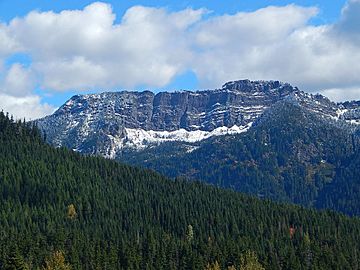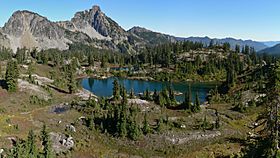Rampart Ridge (Washington) facts for kids
Quick facts for kids Rampart Ridge |
|
|---|---|

Rampart Ridge seen from Snoqualmie Pass area
|
|
| Highest point | |
| Elevation | 5,870 ft (1,790 m) |
| Prominence | 790 ft (240 m) |
| Geography | |
| Location | Alpine Lakes Wilderness Kittitas County, Washington state, U.S. |
| Parent range | Cascade Range |
| Topo map | USGS Chikamin Peak |
| Climbing | |
| Easiest route | Trail approach and Scrambling |
Rampart Ridge is a mountain ridge in Washington state, located in Kittitas County. It stands about 5,870 feet (1,789 meters) tall. This ridge is part of the Cascade Range and is found within the beautiful Alpine Lakes Wilderness. It's also managed by the Wenatchee National Forest.
Rampart Ridge is northeast of Hyak, Washington, and the north end of Keechelus Lake. Its closest taller peak is Alta Mountain, which is about 1.74 miles (2.8 km) to the north-northeast. Dungeon Peak is also nearby, about 0.77 miles (1.24 km) to the south-southwest.
The ridge runs from north to south. On its west side, you'll see steep cliffs overlooking the Gold Creek valley. But on the eastern side, there are gentle meadows with several lakes, like Rachel Lake, Lake Lillian, and the Rampart Lakes. The name "Rampart" means a protective wall, which describes the ridge's appearance. This name was officially chosen in 1918. All the water that runs off the ridge eventually flows into the Yakima River.
Weather and Climate
Rampart Ridge is in a "marine west coast" climate zone. This means it gets a lot of moisture from the Pacific Ocean. Most of the weather systems start over the Pacific and move northeast towards the Cascade Range.
When these weather systems hit the tall Cascade Mountains, they are forced to rise. As they go higher, they cool down and drop their moisture as rain or snow. This process is called Orographic lift. Because of this, the western side of the Cascades gets a lot of rain and especially heavy snowfall in winter.
During winter, the weather is often cloudy. However, in summer, high-pressure systems over the Pacific Ocean usually bring clear skies. The snow in this area tends to be wet and heavy because of the ocean's influence. This can sometimes lead to a risk of avalanches.
How Rampart Ridge Was Formed
The Alpine Lakes Wilderness, where Rampart Ridge is located, has some of the most rugged and amazing landscapes in the Cascade Range. You can find jagged peaks, deep valleys carved by glaciers, and granite rock walls. There are also more than 700 mountain lakes!

The story of how the Cascade Mountains formed goes back millions of years. It started in the late Eocene Epoch. At that time, the North American Plate was slowly moving over the Pacific Plate. This movement caused many volcanic eruptions and created new rock. Also, small pieces of the Earth's crust, called terranes, came together to form the North Cascades about 50 million years ago.
Later, during the Pleistocene period (which began over two million years ago), huge sheets of ice called glaciers moved across the land many times. As they moved, they scraped and shaped the landscape, leaving behind rock and debris. The last glaciers in the Alpine Lakes area started to melt and retreat about 14,000 years ago.
The "U"-shaped valleys you see in the area were carved out by these glaciers. The combination of the land being pushed up (called uplift) and cracks forming in the Earth's crust (called faulting), along with the action of glaciers, created the tall peaks and deep valleys of the Alpine Lakes Wilderness.




